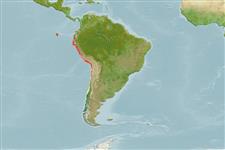>
Scombriformes (Mackerels) >
Centrolophidae (Medusafishes)
Etymology: Schedophilus: Name from Greek words 'phylos' (Φίλος), t) meaning 'one who likes' and "s 'shedia' (Σχεδία) which means raft; literally means 'the one who likes rafts'. This probably refers to the lifestyle ot the juveniles of this genus (Michail Ragousis, mar10091@marine.aegean.gr, pers. Comm. 01/16) which are epipelagic and associate with floating jellyfish.
Eponymy: Dr Richard Lee Haedrich (1938–2017) was an ichthyologist, marine biologist and oceanographer who was a specialist in this group of fishes and how they relate to the marine environment. [...] (Ref. 128868), visit book page.
Environment: milieu / climate zone / depth range / distribution range
Ecología
marino; rango de profundidad ? - 180 m (Ref. 36656). Tropical
Eastern Pacific: Peru.
Tamaño / Peso / Age
Maturity: Lm ? range ? - ? cm
Max length : 75.0 cm TL macho / no sexado; (Ref. 55763); common length : 30.0 cm TL macho / no sexado; (Ref. 55763)
Short description
Claves de identificación | Morfología | Morfometría
Body moderately deep and compressed; dorsal fin with 6 weak spines and 22 to 23 soft rays (VI, 22-23); its origin generally anterior to the insertion of the pectoral fins (juveniles) or above them (adults); anal fin with 15 to 16 rays; pectoral fins pointed; scales deciduous; dorsal area of juveniles with dark lines; body entirely dark gray or brown gray in adults (Ref. 55763).
Minimum depth from Ref. 58018.
Life cycle and mating behavior
Madurez | Reproducción | Puesta | Huevos | Fecundidad | Larva
Eschmeyer, W.N. (ed.), 2000. Catalog of fishes. Updated database version of November 2000. Catalog databases as made available to FishBase in November 2000. (Ref. 36656)
IUCN Red List Status (Ref. 130435: Version 2024-1)
Threat to humans
Harmless
Human uses
Herramientas
Special reports
Download XML
Fuentes de Internet
Estimates based on models
Preferred temperature (Ref.
123201): 13.3 - 15.6, mean 14.8 °C (based on 14 cells).
Phylogenetic diversity index (Ref.
82804): PD
50 = 0.5039 [Uniqueness, from 0.5 = low to 2.0 = high].
Bayesian length-weight: a=0.00891 (0.00403 - 0.01972), b=3.10 (2.91 - 3.29), in cm total length, based on LWR estimates for this (Sub)family-body shape (Ref.
93245).
Nivel trófico (Ref.
69278): 4.1 ±0.6 se; based on size and trophs of closest relatives
Resiliencia (Ref.
120179): Medio, población duplicada en un tiempo mínimo de 1.4-4.4 años (Preliminary K or Fecundity.).
Fishing Vulnerability (Ref.
59153): Moderate to high vulnerability (50 of 100).
